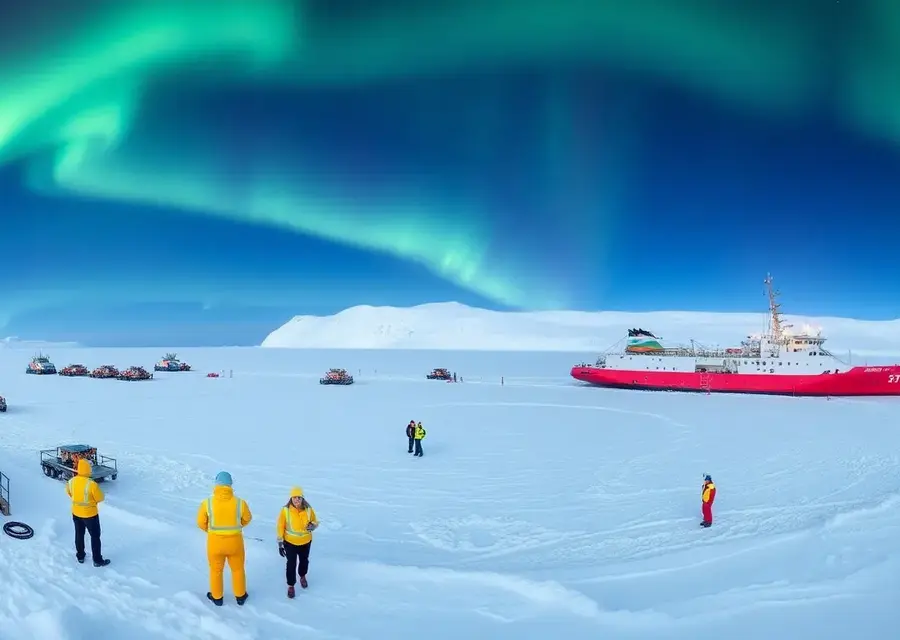Antarctic Science Cooperation: How Global Collaboration Shapes Polar Research
- THE MAG POST

- Aug 24
- 9 min read

Antarctic science cooperation remains a hinge between curiosity and policy, a topic where climate signals meet international diplomacy. As polar researchers push the boundaries of ice, weather, and ecosystem dynamics, the conversation widens to include governance, funding, and fairness. In recent years, the expansion of stations, the emergence of new players, and shifting budgets have reframed how nations share data, coordinate fieldwork, and publish findings. Antarctic science cooperation is not just about who writes the papers, but about how the global community sustains a rigorous, transparent, and collaborative research culture in one of Earth’s most challenging frontiers.
From the dry logbooks of field crews to the high-speed pipelines of satellite data, the topic threads through policy debates, treaty agreements, and public understanding of climate risk. This piece investigates how scientists, funders, and governments navigate competing claims, while emphasizing that robust collaboration accelerates discoveries and helps address global challenges such as warming seas, shifting habitats, and geopolitical tensions at the edge of the world. In short, Antarctic science cooperation is a shared enterprise that invites scrutiny, transparency, and sustained investment from diverse partners.
Antarctic science cooperation: Global implications for polar research
Antarctic science cooperation is remolding the map of polar discovery, turning treaties into hands-on collaboration that translates ice into insight. The struggle to understand ice sheets, ocean circulation, and ecosystem shifts now unfolds across laboratories, ships, and remote field camps, with researchers and policymakers learning to harmonize goals, data access, and long-term capacity building. This evolving landscape compels us to rethink who hosts experiments, who shares data, and how results are communicated to the world. The prize is a more resilient, transparent, and productive scientific enterprise at the planet’s southern hinge.
Antarctic science cooperation and the treaty framework
The Antarctic Treaty System creates a common stage where science can flourish beyond national rivalry. It codifies principles that prioritize peaceful use, freedom of scientific investigation, and the sharing of research outcomes, while acknowledging the need for oversight and responsible behavior. As new actors participate, the treaty’s governance mechanisms adapt to balance access with safeguards, ensuring that data, samples, and field observations are treated as shared assets rather than strategic weapons. This framework underpins confidence, enabling researchers from varied backgrounds to pursue ambitious polar questions under a unified mandate.
With each consultative meeting, the alliance tests its resilience against new data demands and broader geopolitical tensions. Yet the core ethos remains: science thrives best when collaboration is anchored in transparency and peer review. The treaty’s flexible scaffolding supports joint expeditions, cross-border data integration, and multi-institution partnerships, reinforcing that the most meaningful Antarctic breakthroughs arise when scientists pool resources, standardize protocols, and publish openly for global scrutiny and replication.
Antarctic science cooperation: tools, stations, and data-sharing as enablers
Modern polar science hinges on a web of observatories, research stations, and mobile platforms that extend the reach of a single nation’s capabilities. As vessels like icebreakers and cargo ships deliver essential equipment, they also carry the promise of faster knowledge transfer and more frequent sampling across seasons. Data-sharing portals, harmonized metadata, and interoperable sensors transform scattered measurements into cohesive narratives about climate dynamics, sea-ice trends, and life in extreme environments. The result is a living mosaic of observations rather than isolated snapshots.
Advances in autonomous instruments, remote sensing, and real-time communication reduce the lag between fieldwork and analysis. Collaborative projects grow when partners contribute specialized expertise, whether in biology, meteorology, or oceanography, and when data policies incentivize timely release. In this ecosystem, transparency is as important as technology: schemas for open data, quality control, and reproducibility help ensure that every dataset informs global models and informs decision makers about risk, resilience, and adaptation strategies across the southern oceans.
Antarctic science cooperation amid funding shifts and strategic narratives
Funding landscapes are shifting, and Antarctic science cooperation must adapt to these new currents. When major programs adjust budgets or prioritize different exploration paths, researchers look to international collaboration, joint grant proposals, and shared facilities to preserve momentum. The aim is not merely to conserve existing capabilities but to expand them through cost-effective partnerships, enabling larger, more ambitious experiments that could not be sustained by a single nation alone. In this environment, strategic optics matter as much as technical prowess.
Funding dynamics in the US and allied nations
Public funding for polar research often becomes a strategic conversation about national priorities, scientific leadership, and global influence. Shifts in the United States’ polar programs, for example, reverberate through partner institutions, potentially accelerating or slowing breakthroughs in glaciology, microbiology, and satellite telemetry. Yet, history shows that well-structured international collaborations can absorb funding variability by sharing costs, spreading risk, and centralizing expensive infrastructure like icebreaker fleets or high-performance laboratories in accessible hubs.
Other countries respond by elevating their own investments and by inviting multinational consortia to co-manage projects. In practice, this means more joint calls for proposals, standardized data agreements, and shared training opportunities that broaden participation beyond traditional research giants. The net effect is a polar science ecosystem that remains robust even when a single funding stream tightens, preserving momentum toward transformative discoveries in climate science and beyond.
China’s expanding footprint and collaborative opportunities
The narrative around Antarctic science cooperation increasingly recognizes China as a significant and engaged actor, expanding its network of stations, collaborations, and publications. Rather than viewing growth as competition, many analysts highlight opportunities for shared missions, capacity building, and joint experiments that leverage complementary strengths. This attitude aligns with the treaty’s spirit of inclusive participation and helps ensure that data and insights flow across borders in ways that strengthen global understanding of polar processes and their planetary consequences.
As new infrastructure emerges, partners emphasize transparent planning, public reporting, and joint training programs to build mutual trust. Cooperative ventures can span atmospheric science, marine biology, glaciology, and space-weather research, generating a more integrated picture of how Antarctica interacts with Earth’s climate system. The outcome is a durable, multi-lateral framework in which China’s capabilities augment a broader scientific enterprise rather than fragment it into competing silos.
Antarctic science cooperation and media narratives versus on-ground reality
Media portrayals often tilt toward dramatic framing of who leads polar science, yet the day-to-day work of collaboration is more nuanced, iterative, and patient. In practice, researchers from diverse nations routinely align methodologies, share datasets, and co-author papers that reflect a mosaic of perspectives. The reality on the ice involves careful logistics planning, long-term monitoring campaigns, and the gradual accumulation of evidence that withstands scrutiny across institutions and languages. This is the backbone of credible Antarctic science cooperation.
Media framing vs. scientific practice
Journalistic narratives can oversimplify the dynamics of international research by highlighting competition over cooperation. However, seasoned researchers know that progress emerges from repeated cycles of data exchange, joint fieldwork, and cross-checking results among international teams. The strength of Antarctic science cooperation lies not in dramatic headlines but in the quality of models that emerge from large, diverse data sets and the reproducibility of findings that withstand cross-national verification.
Policy discussions echo this complexity, pushing for fair credit, transparent funding pathways, and explicit data-sharing agreements. When decisions are grounded in evidence rather than rhetoric, collaborations persist even as political winds shift. The net effect is a more resilient scientific enterprise that advances climate understanding while building trust among partners, funders, and the public who rely on robust, open research to guide actions in a fragile polar environment.
Balanced policy decisions and scientific fairness
Fairness in Antarctic science cooperation means ensuring equitable access to data, opportunities, and capacity-building resources. It also means recognizing the contributions of researchers from smaller programs who add essential diversity of thought and approach. Policy makers increasingly favor shared governance models, where decision-making power, funding, and leadership roles are distributed to reflect global participation while maintaining high standards for data integrity and methodological rigor.
As the science grows in scope, so does the responsibility to maintain ethical collaboration. This includes transparent approval processes for fieldwork, open reporting of results, and safeguards against misappropriation of shared technology or information. The result is a sustainable, inclusive ecosystem where scientific fairness reinforces the trust that underpins long-lasting Antarctic partnerships and the reliability of discoveries that affect global climate policy.
Antarctic science cooperation: data sharing, transparency, and dual-use governance
In the polar realm, data sharing is not merely a courtesy—it is a strategic necessity that accelerates understanding of rapid environmental change. An open culture, with standardized metadata and accessible archives, enables researchers to validate results, reproduce experiments, and build increasingly accurate climate models. Transparency also reassures funders and the public that collaborative work adheres to agreed-upon norms and safeguards. This is essential to sustain the momentum of Antarctic science cooperation through shifting political landscapes.
Open data cultures and trust building
Open data practices answer the court of public opinion by demonstrating accountability and encouraging independent verification. When research teams adopt common formats, publish protocols, and provide clear provenance for datasets, the scientific community can evaluate quality and significance with confidence. Trust is reinforced when institutions demonstrate timely data releases, reproducible analyses, and consistent adherence to ethical standards across all partners, irrespective of geography or funding source.
Beyond transparency, open access to code and workflows helps early-career researchers engage in meaningful contributions. Collaborative platforms and shared training materials foster a global community where ideas flow freely, yet remain anchored by rigorous peer review and governance agreements. The payoff is accelerated discovery, richer educational experiences, and a polar science landscape that welcomes broader participation and innovation.
Dual-use technologies and oversight
Some Antarctic technologies, such as high-resolution sensors, satellite communications, and data-processing tools, may have dual-use potential with national security implications. This reality necessitates thoughtful governance that protects sensitive applications while preserving scientific openness. Clear policies, robust export controls where appropriate, and transparent risk assessments help ensure dual-use concerns do not stifle legitimate research or international collaboration.
Effective oversight combines expert input from scientists, legal scholars, and policymakers to balance innovation with responsibility. Open dialogues about potential misuse, coupled with well-defined access controls, enable researchers to pursue frontier science without compromising safety or strategic interests. In this way, dual-use governance becomes a constructive element of Antarctic science cooperation, reinforcing safeguards while keeping the focus on the shared pursuit of knowledge and climate understanding.
The Antarctic Treaty System in action: governance, logistics, and leadership
The Antarctic Treaty System remains the backbone of cooperative science, guiding governance norms, dispute resolution, and collaborative priorities across the continent. Its enduring principles prioritize peaceful research, freedom of scientific inquiry, and the equitable sharing of discoveries. As the network of stations and research programs expands, practical governance adapts to ensure that logistics, safety, and environmental stewardship keep pace with ambition. The system’s strength lies in its ability to harmonize national interests with collective scientific goals.
Treaty principles guiding research priorities
At the core of Antarctic science cooperation, treaty principles create a positive, predictable environment for long-term research. The emphasis on openness, peer participation, and environmental respect shapes what projects are initiated, who leads them, and how results are disseminated. This framework helps prevent unilateral actions that could undermine shared goals and ensures that critical questions about climate change, biodiversity, and glaciology receive coordinated, cross-border attention.
The practical effect is a prioritization of transferable knowledge and robust safety protocols. By aligning funding, staffing, and field operations with treaty-guided ethics, researchers can plan multi-year campaigns that leverage international expertise and shared facilities. The outcome is a durable infrastructure for polar science that remains capable of addressing evolving environmental realities while upholding the treaty’s spirit of peaceful, cooperative exploration.
Logistics, stations, and who does the science
Logistics determine the pace and scope of Antarctic science. The construction, maintenance, and accessibility of stations shape what research can be carried out and by whom. As nations expand their presence—with new stations, runways, and supply chains—the question shifts from “who owns the data” to “how do we jointly manage the journey from field to publication?” The answer lies in shared scheduling, joint logistics planning, and interoperable research facilities that reduce redundancy and maximize scientific return.
Distribution of tasks and leadership roles is also evolving. Collaborative projects increasingly rely on distributed teams that contribute specialized skills from universities, national labs, and private partners. By designing governance structures that promote fair credit, transparent budgets, and cross-institution mentorship, the Antarctic Treaty System supports a diverse ecosystem where many voices enrich the science and the decisions that flow from it.
The Final Takeaways: Antarctic science cooperation shaping tomorrow's polar science
The ultimate lesson from the current wave of Antarctic science cooperation is that knowledge advances most rapidly when nations pool curiosity, resources, and integrity. This is not merely about publishing more papers; it is about building a durable culture of collaboration that withstands political shifts and scientific skepticism. If stakeholders align incentives toward openness, capacity building, and rigorous peer review, the southern ice will yield clearer signals about global change and better guidance for policy and resilience planning.
Key lessons for policymakers and funders
Policymakers should prioritize stable, predictable funding for multinational expeditions, data infrastructure, and early-career training across borders. Allocating resources to interoperable platforms reduces redundancy and accelerates discovery, while clear data-sharing agreements protect intellectual property and public trust. Funders benefit from supporting collaborative consortia that diversify risk and broaden participation beyond traditional powerhouses, creating a more resilient and innovative polar science ecosystem.
Engagement with international partners must emphasize transparency, accountability, and environmental stewardship. Clear reporting on outcomes, impacts, and ethical considerations strengthens legitimacy and encourages continued cooperation. As climate challenges intensify, the capacity to mobilize diverse expertise quickly becomes a strategic advantage for global science and policy alike.
What researchers should watch next
Researchers should monitor emerging data standards, open-access policies, and collaborative funding opportunities that broaden participation. Keeping pace with evolving environmental conditions will require flexible research designs, cross-disciplinary approaches, and the willingness to share methods and data in real time. Building networks that span continents nurtures mentorship, enhances reproducibility, and sustains momentum across generations of scientists who will inhabit the next era of polar science.
Aspect | Takeaway |
Treaty framework | Foundation for peaceful, collaborative polar science with open data norms |
Funding shifts | International partnerships absorb volatility and maintain momentum for major projects |
Global players | China, US, and others expand stations and collaborations under shared rules |
Data sharing | Open, standardized datasets accelerate models and policy relevance |
Governance | Transparency, ethics, and environmental stewardship guide joint research |






















































Comments